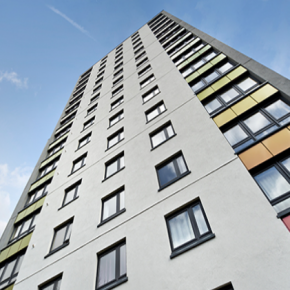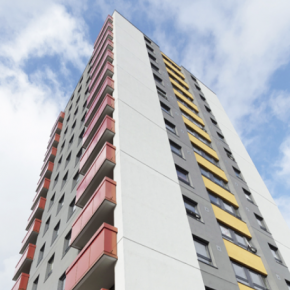
What specifiers should look for in their EWI system
Alumasc’s Technical Director Mark Gibbs discusses what specifiers should look for in their EWI system for high-rise and the importance of safe installation.
Specification for the multi-storey application of External Wall Insulation is very different to that of low-rise projects, with health and safety procedures being a key consideration in the thermal upgrade of high-rise buildings.
High rise projects for the last 25 years have been refurbished using EWI, as a cost effective method of achieving thermal and aesthetic upgrade of buildings.
EWI solves the issue of condensation, water ingress and poor thermal performance of many of the blocks and provides a U-value to comply with current Building Regulations.
The appropriate type of EWI insulation board is mechanically and adhesively fixed to the substrate to achieve the thermal requirements of the project. A polymer modified reinforcing base coat, incorporating a fibreglass reinforcement mesh, is then applied.
Various finishes are available, ranging from traditional dash or painted renders to more modern through-coloured silicone renders, once it has fully cured.
The insulation boards of high-rise EWI specification must be adhesively and mechanically fixed. To accommodate higher wind loads, calculations must be made and the edge zones, and increased mechanical fixings are required for external corners and openings.
The calculations must always be conducted by Structural Engineering Consultants to ensure structural stability, required performance and system longevity.
For use in high-rise application, specified EWI systems must be officially accredited and approved. The system requires a large scale fire test or reaction to fire test when used above 18m in height.
There are additional detailing considerations compared to low-rise, as well as through-the-wall square metre rates. Including parapet, lightening conductor, CCTV, external lights, robust window cill details, ground floor entrance areas etc.
It is critical that all detailing is robust and installed as per specification .Any repairs are more difficult and costly to address than for low-rise projects once the wall access is removed. Scaffold ties should be fixed in the most practical locations and protected scaffolding is recommended.
Mast climbers are an economical and faster track option for EWI install, however they offer less protection to newly installed work. Programming considerations should always allow for weather conditions.
Alumasc Facades,
White House Works,
Bold Road,
Sutton,
St Helen's,
Merseyside,
United Kingdom
WA9 4JG
Phone: 01744 648400
Visit Supplier's page
Latest news

28th March 2025
FLIR Si1-LD Acoustic Imaging Camera for Compressed Air Leak Detection
FLIR, a Teledyne Technologies company, introduces the Si1-LD, an industrial acoustic imaging camera that brings faster and more accurate compressed air leak detection to those operating on a modest condition monitoring budget.
Posted in Acoustics, Noise & Vibration Control, Articles, Building Industry News, Building Products & Structures, Building Services, Facility Management & Building Services, Information Technology, Innovations & New Products, Retrofit & Renovation, Sustainability & Energy Efficiency, Thermal Imaging and Monitors
28th March 2025
LIFTEX 2025 Seminar programme announced
Registration has opened for LIFTEX 2025. Now in its 37th year, LIFTEX 2025 is the UK’s only dedicated exhibition for the lift, escalator and access industry and takes place only once every three years.
Posted in Access Control & Door Entry Systems, Accessibility, Articles, Building Industry Events, Building Industry News, Building Products & Structures, Building Regulations & Accreditations, Building Services, Exhibitions and Conferences, Facility Management & Building Services, Health & Safety, Retrofit & Renovation, Security and Fire Protection, Seminars
28th March 2025
MCRMA welcomes ArcelorMittal UK to membership
A UK division of the global steelmaking business ArcelorMittal has become the latest new member of the MCRMA, the industry association representing the metal building envelope sector.
Posted in Articles, Building Associations & Institutes, Building Industry News, Building Products & Structures, Building Systems, Cladding, Facades, Posts, Restoration & Refurbishment, Retrofit & Renovation, Roofs, Steel and Structural Frames, Walls
28th March 2025
Abloy: Managing access and security in Telecoms infrastructure
Telecommunications infrastructure underpins much of the world’s economy and critical services, but the industry is vulnerable to physical threats, from sabotage to theft and accidental damage, as Abloy UK explains here…
Posted in Access Control & Door Entry Systems, Architectural Ironmongery, Articles, Building Industry News, Building Products & Structures, Building Regulations & Accreditations, Building Services, Doors, Facility Management & Building Services, Information Technology, Innovations & New Products, Posts, Publications, Research & Materials Testing, Retrofit & Renovation, Security and Fire Protection
 Sign up:
Sign up: 